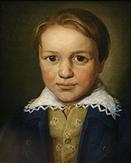

Classical Music Part II
Overview
In this unit, we will focus on musical forms from the classical period and two famous composers from that era, Mozart and Beethoven. We will also have some listening examples from some other composers of the Classical Period.

Forms in Classical Music
We covered the typical Symphonic form that Haydn perfected in the previous unit so we will not discuss that in depth again. However, we do need to review it. Symphonic form consists of four movements. The first itself is in sonata form containing thematic material introduced in the exposition, changed in the development, and recapped in the recapitulation. The second movement is usually slow, gentle, and relaxing in direct contrast to the first. It too is often written in sonata form, but without the repeats. The third movement is typically a minuet and trio, a lighter dance-like piece. The fourth movement is like the grand finale of a fireworks show. It contains a little bit of everything that was presented around the thematic material, and repeats the theme many times but is typically shorter than the first movement. Most musical pieces from this period follow this type of pattern with four movements; however, classical sonatas may have two, three, or four movements.
Sometimes a composition may even have a short section after the recapitulation that makes a stronger closing statement. This ending is known as the coda. It finishes more conclusively because it repeats the theme and ends in the tonic key, the key in which the original theme was introduced.
Theme and Variations is another form made popular during this time period. This form is just what it says it is. A theme is introduced and is usually referred to as “A”. Then it is repeated many times, each being different than the one before. The variations are usually referred to as A1, A2, A3, etc. or as A’, A’’, A’’’, etc. Although the variations are changed, they usually remain about the same length as the theme. Each variation can differ in mood, melody, rhythm, harmony, accompaniment, dynamics, or tone color. These changes help to give the variations their own identities. The following are some examples of how the variations are composed: the melody may change from the top (soprano) line to the bottom (bass) line, the key may change from major to minor, the rhythms may all be doubled to sound longer and slower, or they may be cut in half to sound a lot quicker. The theme and variations may be written as one long piece or each may have a pause before starting the next. Please view the following flash tutorial for great examples of theme and variation.
Here is another great example of Theme and Variations form by Mozart, “Twinkle, Twinkle, Little Star”. Please listen as you will be asked to critique it. We will discuss Mozart in depth later in this unit.
Another form that was made poplar during this period was the Minuet and Trio. We touched briefly on this form in the last unit when discussing the third movement of Haydn’s symphonic form. The minuet was typically thought of as a stately form of dance. Often times while it was being performed, the dance partners would bow and/or curtsy to each other. On the contrary, during this period of music, the minuet was written for the purpose of listening, not for dancing.
The Minuet and Trio is written in triple meter, or what is commonly known as ¾ time. It usually calls for a moderate tempo, and follows an A B A pattern: minuet (A), trio (B), minuet (A). Within the A B A pattern, is a repeated pattern. It breaks down as follows:
Minuet |
Trio |
Minuet |
A |
B |
A |
a (repeated) b a’ (repeated) |
c (repeated) d c’ (repeated) |
a b a’ |
When, actually looking at a piece of music written in this form, the performer knows to return to the Minuet section (the beginning) after the Trio because the words da capo are written. Da capo literally means from the beginning. Notice the second time the minuet is played that there are no repeats and it is played straight through. We will discuss Beethoven in greater depth later on in this unit; however it is important to note that in many of his compositions, he replaced the repetition of the minuet (third movement) with a scherzo. A scherzo is usually in A B A form and triple meter as is the minuet. On the contrary, a scherzo moves more quickly, generating more energy and rhythmic drive.
Please listen to the following excerpt of Mozart’s Minuet and Trio known as Eine Kleine Nachtmusik, A Little Night Music. It is a serenade. By definition, a serenade is an instrumental piece that is light in mood, and is usually performed as evening entertainment.
Another form made popular during the classical period of music history was the rondo. A rondo consists of and utilizes a very melodic, tuneful main theme that always is brought back after each other section or theme is played. A typical rondo pattern would look like one of the following:
A B A C A or A B A C A B A
The main theme is usually very simple to remember making it easy for the listener to hear when it returns in the piece. It is also usually lively, meaning not slow and somber. The rondo is composed as an independent piece or is written as a movement of a symphony, string quartet, or sonata. Due to its liveliness and bouncy happiness, it is often used for the finale of a piece.
Another musical form combines two that we have previously discussed the sonata and the rondo. Together they make the sonata-rondo. The sonata-rondo contains the development section from the sonata which is typically labeled as A B A development A B A.
Although it was discussed with Haydn in the last unit, we are going to add a little more to our information about the classical symphony. By definition, a symphony is an extended, ambitious composition typically lasting between 20 and 45 minutes, showcasing the entire range of tone colors and dynamics of the classical orchestra. Recall that a classical symphony usually consists of four movements: 1. a dramatic, fast movement; 2. a slow lyrical movement; 3. a dancelike movement (a minuet or scherzo); and 4, a bolder closing fast movement. In most classical symphonies, each movement is independent of the others and considered to be self-contained, as each has their own set of themes. Rarely will the theme from one movement be repeated in another movement so the use of the tonic key in three of the movements is very important to the overall flow and consistency in the symphony.
 A concerto from the classical period consists of three movements for an instrumental soloist and orchestra. It is composed to showcase the soloist’s virtuosity and interpretive abilities along with the wide range of tone colors and dynamics in the orchestra. In a composition like this, both the soloist and the orchestra serve equally important roles in the overall performance of the concerto. Concertos are like symphonies in that they can last anywhere from 20 to 45 minutes. However, they differ from symphonies in that a classical concerto has only three movements instead of the four movements of the symphony. The movement missing in the concerto is the minuet or scherzo section. A concerto is composed so that the first movement is fast, the second is slow, and the third returns to a fast tempo. The first movement and sometimes the last contain a cadenza which is a special unaccompanied showpiece for the soloist that is usually improvised. The soloist’s cadenza is introduced by a chord being sustained by the orchestra. This note in the orchestra’s music is notated with a fermata which indicates to musicians that they need to pause. The fermata is located above the note or rest that the musician is supposed to hold.
A concerto from the classical period consists of three movements for an instrumental soloist and orchestra. It is composed to showcase the soloist’s virtuosity and interpretive abilities along with the wide range of tone colors and dynamics in the orchestra. In a composition like this, both the soloist and the orchestra serve equally important roles in the overall performance of the concerto. Concertos are like symphonies in that they can last anywhere from 20 to 45 minutes. However, they differ from symphonies in that a classical concerto has only three movements instead of the four movements of the symphony. The movement missing in the concerto is the minuet or scherzo section. A concerto is composed so that the first movement is fast, the second is slow, and the third returns to a fast tempo. The first movement and sometimes the last contain a cadenza which is a special unaccompanied showpiece for the soloist that is usually improvised. The soloist’s cadenza is introduced by a chord being sustained by the orchestra. This note in the orchestra’s music is notated with a fermata which indicates to musicians that they need to pause. The fermata is located above the note or rest that the musician is supposed to hold.
The last form we are going to discuss from the classical period is the string quartet. The string quartet is the most important form of chamber music from this period in music history. Chamber music was composed to be performed in a more intimate setting such as in a room in a palace or someone’s home. Usually chamber music is only performed by two to nine musicians, with each part being played by only one musician. A string quartet is composed for two violins, a viola, and a cello. Many listeners compare a string quartet to a conversation being held between four different people. They answer each other and the discussion rotates between the four of them. A string quartet usually has four movements just like a symphony:
- fast
- slow
- minuet or scherzo
- fast
Other popular forms of chamber music from the classical period include the piano sonata, violin sonata, the piano trio which is written for piano, violin, and cello, and the string quintet which utilizes two violins, two violas, and a cello.
Wolfgang Amadeus Mozart
Wolfgang Amadeus Mozart was born in Salzburg, Germany in 1756. He was considered to be a child prodigy in composing, improvising, and performing on the harpsichord. At the age of twenty-five, he moved to Vienna and became financially stable on his own as a composer, private teacher, and performer. We often use the phrase “jack of all trades, master of none” to describe individuals who are good at lots of different things, but who are not great at any of them. This phrase does NOT describe Mozart. He was great at all of them and was considered to be one of the greatest musicians in the history of western music.
Mozart inherited his musical talent from his father, Leopold Mozart who was a violinist, composer, and author. Leopold took a great deal of pride in his children and educating them in music as well as other subjects. Wolfgang’s sister, Nannerl, also toured with him and their father. She too was considered to be a music prodigy.
Mozart began touring Europe in 1762 and did so until 1773. He performed and composed for very famous and influential people. His works were representative of all of the different European styles. While in
At the age of fifteen he was assigned to the court orchestra of the prince-archbishop of Salzburg, Germany, but never did find another position that would give him a better chance at success. It was difficult for Mozart to work in a court orchestra since he was use to the fame he had received as a child prodigy. At the age of twenty-five, he was so frustrated that he left
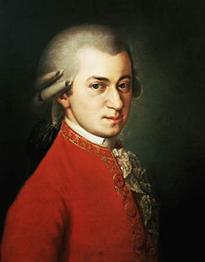
During his first few years in Vienna, he was very successful composing his German opera, Die Entfuhrung aus dem Serail (The Abduction from the Seraglio), performing concerts that were attended by the nobles and emperors, having his compositions published, teaching music, and earning the friendship of Franz Joseph Haydn whom we discussed in the last unit. His success in writing operas continued with Le Nozze di Figaro (The Marriage of Figaro) and Don Giovanni. Please listen to the following excerpts from his famous operas.
In 1791, Mozart received a commission to write the comic opera Die Zauberflote (The Magic Flute). This would be his last complete work before his death later on that same year. Please listen to the following excerpt from The Magic Flute.
After finishing the opera, he was commissioned to write a requiem, which is a mass for the dead. His health began deteriorating so he began thinking that he was actually composing his own requiem. However, he died shortly before his thirty-sixth birthday. The requiem was not finished until a friend and pupil completed the work. Please listen to the following excerpt from his last work.
The following is an example of sequencing, a technique used by composers to unify the development of a theme with its original statement, from Mozart’s Sonata in C Major, K 545. It is specifically a harmonic sequence in which the original theme is repeated at a new pitch level, but the intervals between notes are maintained from the original statement to the new pitch set.
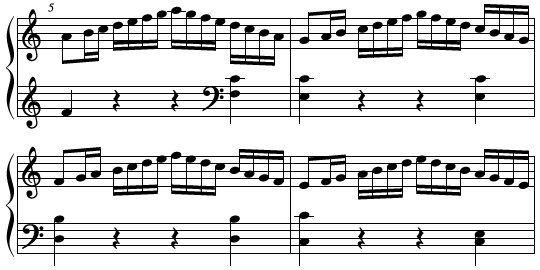
Mozart wrote almost six hundred musical compositions in his short lifetime. If you notice above the sample of sequence shown above, it is taken from Mozart’s Sonata in C, K 545. His compositions are numbered and listed in chronological order. Ludwig von Kochel, “K”, catalogued Mozart’s work in 1862. Originally his pieces were numbered from K 1 to K 626. Some of the original number assignments have changed as more information about Mozart and his music has been discovered. Please watch the following eight video segments about Wolfgang Amadeus Mozart.
Famous Composers: Wolfgang Amadeus Mozart: 1756-1791 |
|
Please listen to the following performances of his compositions.
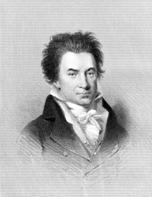
Ludwig Van Beethoven
Ludwig Van Beethoven is considered by some to be a musical genius. Not only did he have a profound influence on other composers of his time, he left a legacy beyond compare. He also brought about change through his use of musical expression in his compositions. Like Mozart, Beethoven was born into a musical family.
Beethoven’s musical career is usually divided into three sections: early (1770-1802); middle (1803-1814); and late (1815-1827). His early career focused on when he mastered the musical language and genres of his time. It was also during this time that he suffered a crisis in his life as he gradually started to lose his hearing. During the middle of his musical life, he achieved a new level of drama and expression. The compositions of his late career are more introspective and difficult, and this is when he became more withdrawn from society due to his inability to hear and the emotional strain that this caused him to suffer.
Beethoven at age 13
Beethoven’s Early Career (1770-1802)
Beethoven was born in Bonn, Germany in 1770. He served as assistant to the court organist while eleven years old, and had several of his own compositions published by age twelve. He played for Mozart when he was sixteen, and Mozart predicted then that Beethoven would give the world something special. Before turning twenty-two, he left
His first years in Vienna were filled with hard work, public praise, and growing confidence. After not being completely satisfied with his studies under Haydn, Beethoven did start studying with another teacher. The people of
At the age of twenty-nine, Beethoven noticed the first signs and symptoms that he was losing he hearing. After visiting doctors, he was given the same crushing news, that there was nothing they could do to stop him from going deaf. This news sent Beethoven to thoughts of suicide, but it was his love for music that kept him alive. In fact on
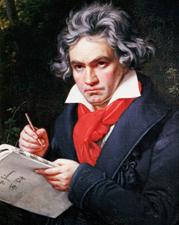
Some of his compositions from the early period in his music career include: piano sonatas, string quartets, and his first symphony. Beethoven’s Sonata No. 14 in C Sharp Minor Moonlight, Op. 27 No. 2 (Moonlight Sonata) is one famous piece from his early career. Please listen to the first movement of it now.
His most famous piano sonata from this time is the Piano Sonata in C Minor (Sonata Pathetique) which was written in 1798. In his early writing, Beethoven’s original and powerful writing style foreshadowed what was to come in the romantic period of the nineteenth century. We will now take a more in depth look at the first movement of his Sonata Pathetique.
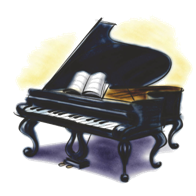
Piano Sonata in C Minor (Sonata Pathetique)
The first movement starts with a slow, fantasia-like intense introduction with a dotted rhythmic pattern: long-short-long-short-long-long. It is written in a sequence (discussed earlier) and seems to pose a set of unresolved questions as it repeats on ascending (moving higher) pitch levels. The introduction occurs twice in the first movement and is intensified by dissonant chords, sudden contrasts of dynamics (volume), sudden changes in register (pitch level), and pauses that add anticipation.
The tension that he has so masterfully built in his composition remains in the allegro con brio that follows the introduction. An allegro con brio is a breathless, fast movement in sonata form (exposition, development, recapitulation). The opening idea of the allegro con brio, the exposition, is characterized by staccato nights played by the right hand and low broken octaves played by the left hand. A broken octave is achieved when two tones an octave apart are played in rapid alternation. Following the opening theme of the exposition, Beethoven composed a bridge section built around an ascending staccato motive (theme). The bridge, like the introduction will return later in the piece. There is a contrasting second theme that Beethoven brings in without even the slightest of pauses. It contains a short motive that repeats while shifting between the low and high registers of the piano. It is restless sounding and begins in a minor key but continues to move through different keys as it builds. The exposition concludes with several themes, including a high running passage and a return of the opening staccato theme.
Through his dramatic and imaginative composition style, Beethoven was able to integrate the slow, dramatic introduction into the allegro section’s development. In fact, it begins with the same dramatic music as the opening of the piece. By Beethoven bringing back the introduction, he adds an immense contrast of tempo, rhythm, and mood. After the four bars of the slow introduction, Beethoven combines two different earlier ideas from the exposition: the staccato bridge theme and a faster-paced version of the introductory motive. He also changed the introductory theme by changing the rhythmic pattern to short-short-short-long-long. He then has the bridge motive being played and developed by the pianist’s left hand. At the same time the right hand has broken octaves. The development is rather short in contrast to the rest of the movement and concludes with a descending running pattern of notes that leads into the recapitulation.
The recapitulation follows the traditional idea of a recapitulation and “recaps” the themes of the exposition in their tonic key of C minor. As discussed earlier, the recapitulation often ends with a coda section and Beethoven held back another surprise for this coda. Just as the listener is expecting the piece to end after a loud dissonant chord, Beethoven wrote in a brief pause after which he again brought back the opening slow introduction. It is more dramatic, however, because Beethoven added in pauses of silence. Then the tempo resumes its fast pace, and the staccato idea and powerful chords close the movement once and for all. Please listen to Beethoven’s Sonata Pathetique. Compare what you hear in the first movement to what has been discussed above. When you listen to the last two movements, compare and contrast them to the powerful first movement.

Beethoven’s Middle Career (1803-1814)
As a result of his change in mental state during this time, his musical style also changed. His love for music and composition is what drove his will to live. This turning point in his musical career is marked by a more ambitious writing style and started around 1803. There was no risk to his successful career by taking this leap and changing style because of his reputation and the overwhelming support of his patrons. The public as well as his publishers also supported the situation because of the “triumphant story” it created: a deaf man composing marvelous pieces of music. By this time, Beethoven was known as one of the best pianists and composers ranking him up at the top alongside Haydn and Mozart.
He was well-liked by the richest of noble families. As a result, he was offered a lifetime annuity to stay in
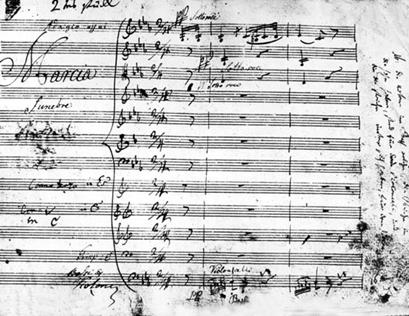
Sinfonia Eroica (Heroic Symphony) Symphony No. 3 in EbMajor
This is the first of Beethoven’s compositions that fully shows his new composing style. The title lets us know that this piece is about the celebration of a hero. Some music historians believe that it exemplifies Beethoven’s heroism and that it represents his life’s experiences with tragedy, his fight to overcome his crisis, and his victory to continue creating music. According to the music analysis of Philip G. Downs, the first movement tells the story of the challenge, struggle, and final victory. The second movement depicts Beethoven’s sympathy toward
Below is an example of chromaticism, the use of many notes from the chromatic scale in a passage, from the Heroic Symphony. The last note, C#, is the chromatic note. It is not a note in the original composition.

Please listen to the short sample from Beethoven’s Sinfonia Eroica.
Please listen to the following samples of some of Beethoven’s other compositions from his middle period of writing.
In his Symphony No. 5 in C Minor, Beethoven seems to demonstrate his will to accept his fate, but not let it defeat him. This struggle is evident as the piece transitions from C minor to C major. The opening motive is one of the best known themes in music history.
Beethoven’s Late Career (1815-1827)
It was now that Beethoven’s problems all seemed to hit him even though he was at the height of his career. His family troubles, deafness, poor health, and the changes in politics and economics of his country, caused Beethoven to pull back his life into isolation. He did not complete as many compositions and also once again changed his style.
Beethoven seemed to focus his composing on writing using musical extremes just to provoke the thoughts of the listeners. When composing variations on a theme, Beethoven always refocused the music on the basics of the theme. He also wrote with more continuity by not writing in definite pauses or breaks between phrases and movements. Beethoven often wrote fugues, compositions in imitative texture that are based on a single subject or phrase that begins with the successive statement of that subject in different voices or parts. When composing a multi-movement work, he often mixed up what was thought of as the traditional order of the movements. Beethoven’s last two major works were Missa solemnis, a mass written for concert performance that was a five-movement symphony, and his Ninth Symphony, written in 1824 it combined new innovation with tradition and was very dramatic and full of emotional expression.
Ludwig van Beethoven changed music and how it was composed for eternity. His freedom to write music and express it how he saw fit opened up new avenues for both the composers and listeners alike. Many of his works became famous right away and have remained so to this day. Please watch the following eight segments about Beethoven.
 |
| Unit 6 Classical Music Part II Worksheet |
| Unit 6 Cornell Notes Worksheet |
